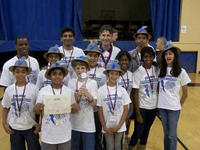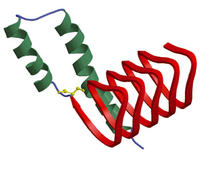-
Antibiotic-resistant bacteria proliferate in agricultural soils
Infectious diseases kill roughly thirteen million people worldwide, annually, a toll that continues to rise, aided and abetted by resistance genes. Now a study finds reservoirs of resistance in agricultural soils
-
-
New antibiotic to make food safer, cows healthier
Chemists discovered a molecule very similar to the antibiotic nisin, found naturally in milk and added to food for decades to fight pathogenic bacteria; the new molecule, geobacillin, is more stable than nisin, which could make it more effective
-
-
Radiation-laced Japanese seafood detected in South Korea

The effects of the Japanese nuclear crisis at the Fukushima Daichii atomic energy plant are continuing to ripple across the world
-
-
CDC: outbreaks linked to imported foods increasing
U.S. food imports grew from $41 billion in 1998 to $78 billion in 2007; as much as 85 percent of the seafood eaten in the United States is imported, and depending on the time of the year, up to 60 percent of fresh produce is imported; the increase in imported food has been accompanied by an increase in foodborne illnesses, with fish and spices the most common sources
-
-
New wheat strain could ease food shortages
Researchers in Australia have developed a new strain of salt-tolerant wheat that could help minimize food shortages
-
-
CDC study finds raw milk is most likely source of dairy outbreaks
A new study by the Centers for Disease Control and Prevention (CDC) finds thatraw milk is 150 times more likely to be the cause offood-borne illnesses than pasteurized milk; a growing number of states have permitted the sale of raw milk
-
-
Universal Detection developing smartphone radiation scanner for food
In the wake of Japan’s nuclear disaster at the Fukushima Daiichi atomic energy plant, concerns over contaminated food supplies have swept the nation, sparking Universal Detection Technology to develop a smartphone radiation detector specifically designed for comestibles
-
-
Cell phone-based sensor detects E. coli
Researchers have developed a new cell phone-based fluorescent imaging and sensing platform that can detect the presence of the bacterium Escherichia coli in food and water
-
-
New app to help fight nonnative species invasion of U.S.
Nonnative species invading the United States — animals, pathogens, and plants — deplete water supplies, poison wildlife and livestock, and damage property in urban and rural areas at a cost of about $138 billion annually; the U.S. Forest Service funded the development of an iPhone application that helps people identify harmful, non-native plants
-
-
Middle school robotics team develops solution to food poisoning

A group of eight middle school students in California has developed an electrolyzed water vending machine that can cheaply and effectively reduce food contamination
-
-
U.S. extends zero tolerance policy to six additional E.Coli serogroups
The U.S. Department of Agriculture has taken additional steps to fight E. coli in the food supply; the new policy adds six E. coli serogroups to the list of sergroups which are not allowed to be present in raw ground beef or the meat used to make raw ground beef; the beef industry says it will be too expensive to implement, and U.S. trading partners said preventing their beef from entering the U.S. unless tested for the six serogroups would violate existing trade agreement
-
-
Using ozone to kill prions dead

Prions are among the worst infectious-disease agents; these proteins are resistant to a wide variety of extreme disinfectant procedures; they have been identified as the culprits behind mad cow disease and chronic wasting disease in animals and humans, and are also implicated in Creutzfeldt-Jakob disease and other prion-related disorders
-
-
Food safety business plan competition
Two Michigan-based organizations announce a business plan competition for ventures in the food safety area; entrepreneurs with new food safety business concepts will compete for $10,000 prize
-
-
Discovery paves way for salmonella vaccine
More than 1.4 million cases of salmonella occur annually in the United States, at an estimated cost of $3 billion and the loss of 580 lives; around the world, this increasingly antibiotic-resistant food-borne bacteria that kills hundreds of thousands of people worldwide each year; , immunologists have taken an important step toward an effective vaccine against salmonella
-
-
Electron beam reduces virus-related health risk in lettuce, spinach
Current health-care costs in the United States associated with foodborne viruses are estimated at about $6 billion; scientists show that electron-beam irradiation can reduce the health risks in iceberg lettuce and spinach, but note that electron-beams are not meant to be used as a “stand-alone” or “clean-up” technology
-
- All
- Regional
- Water
- Biometrics
- Borders/Immig
- Business
- Cybersecurity
- Detection
- Disasters
- Government
- Infrastructure
- International
- Public health
- Public Safety
- Communication interoperabillity
- Emergency services
- Emergency medical services
- Fire
- First response
- IEDs
- Law Enforcement
- Law Enforcement Technology
- Military technology
- Nonlethal weapons
- Nuclear weapons
- Personal protection equipment
- Police
- Notification /alert systems
- Situational awareness
- Weapons systems
- Sci-Tech
- Sector Reports
- Surveillance
- Transportation
Advertising & Marketing: advertise@newswirepubs.com
Editorial: editor@newswirepubs.com
General: info@newswirepubs.com
2010-2011 © News Wire Publications, LLC News Wire Publications, LLC
220 Old Country Road | Suite 200 | Mineola | New York | 11501
Permissions and Policies
Editorial: editor@newswirepubs.com
General: info@newswirepubs.com
2010-2011 © News Wire Publications, LLC News Wire Publications, LLC
220 Old Country Road | Suite 200 | Mineola | New York | 11501
Permissions and Policies
